Hello, friends. I hope you are enjoying the weekend. On this occasion, I would like to share with you some pictures I took a few days ago, while I was walking around Plaza Bolivar in Naguanagua, Carabobo.
This place is very quiet, ideal for reading a book or hanging out in good company. On the periphery, there are several shops, from barbershops to a shopping mall, but undoubtedly the most striking construction is the Church of Our Lady of Begoña, built between 1943 and 1955, after the priest Luis Antonio Rodontaro requested authorization to build a new temple, since before this existed - and still exists - the Colonial Church of Naguanagua, located on the same land, to the left of the new construction, much smaller, as you can see in the third picture.
Hola, amigos. Espero se encuentren disfrutando del fin de semana. En esta ocasión, me gustaría compartirles unas fotos que tomé hace unos días, mientras caminaba por la Plaza Bolívar de Naguanagua, Carabobo.
Este lugar es muy tranquilo, ideal para leer un libro o pasar el rato en buena compañía. En la periferia, hay varios locales, desde barberías hasta un centro comercial, pero sin duda la construcción más llamativa es la Iglesia Nuestra Señora de Begoña, construida entre 1943 y 1955, luego de que el sacerdote Luis Antonio Rodontaro solicitara una autorización para levantar un nuevo templo, ya que antes de este existía —y sigue existiendo— la Iglesia Colonial de Naguanagua, ubicada en el mismo terreno, a la izquierda de la nueva construcción, mucho más pequeña, como pueden apreciar en la tercera fotografía.

Regarding the facade of the Church of Our Lady of Begoña, in the words of chroniclers and historians of the town of Naguanagua:
"The facade is composed of three bodies defined by cornices. The first body presents three doors with molded openings and topped by semicircular arches, the highest framed by pilasters. The third body is crowned by a frontispiece and aligned with it are the towers of a single body, framed by pilasters and a wide cornice, both towers decorated with pinnacles and crowned by an internal cupola..."
Respecto a la fachada de la Iglesia Nuestra Señora de Begoña, en palabras de cronistas e historiadores del poblado de Naguanagua:
“La fachada está compuesta por tres cuerpos definidos por cornisas. El primer cuerpo presenta tres puertas con vanos moldurados y rematados en arco de medio punto, el más alto enmarcado por pilastras. El tercer cuerpo está cornado por un frontispicio y alienados con él se hallan las torres de un solo cuerpo, enmarcado por pilastras y una amplia cornisa, ambas torres decoradas con pináculos y coronadas por una cúpula interna…”

This church is considered a National Historic Monument. The priests Rodontaro Delgado, Jacinto Soto and Medardo Bacalao participated in its construction. It was inaugurated on August 15, 1955, an important date for the inhabitants of the municipality, since that day is celebrated the Day of the Virgin of Begoña.
Esta iglesia es considerada un Monumento Histórico Nacional. En su construcción participaron los sacerdotes Rodontaro Delgado, Jacinto Soto y Medardo Bacalao. Se inauguró el 15 de agosto de 1955, fecha importante para los habitantes del municipio, pues ese día se celebra el Día de la Virgen de la Begoña.

In the words of the chronicler Robert Guinand Castellanos:
"The devotion of the Virgin is lost in the night of the times. Tradition has it that her apparition happened in the vicinity of Bilbao, and the fact that she manifested her desire to remain in that place through the word 'Begoña', which in Basque means 'here I stay', led to the construction there of a hermitage that evolved until it reached the beautiful basilica that today stands on the site. That is why this invocation of the Virgin is known as Santa María de Begoña, patron saint of Bilbao and Vizcaya. This also explains the participation of the Basque colony residing in Venezuela, in the celebration of her feast in Naguanagua.
However, the force of use and custom and perhaps also to make her more ours, most refer to her as the Virgin of La Begoña and speak of the August festivities as the festivities of La Begoña."
En palabras del cronista Robert Guinand Castellanos:
“La devoción de la Virgen se pierde en la noche de los tiempos. Cuenta la tradición que su aparición sucedió en las cercanías de Bilbao, y el hecho de haber manifestado su deseo de permanecer en ese sitio mediante la palabra ‘Begoña’, que en vasco significa ‘aquí me quedo’, llevó a la construcción allí de una ermita que fue evolucionando hasta llegar a la bella basílica que hoy se levanta en el lugar. Por eso esta advocación de la Virgen es conocida como Santa María de Begoña, patrona de Bilbao y Vizcaya. Explica esto también la participación de la colonia vasca residente en Venezuela, en la celebración de su fiesta en Naguanagua.
Sin embargo, la fuerza del uso y la costumbre y quizá también para hacerla más nuestra, la mayoría se refiere a ella como la Virgen de La Begoña y hablan de las fiestas de agosto como las fiestas de La Begoña.”
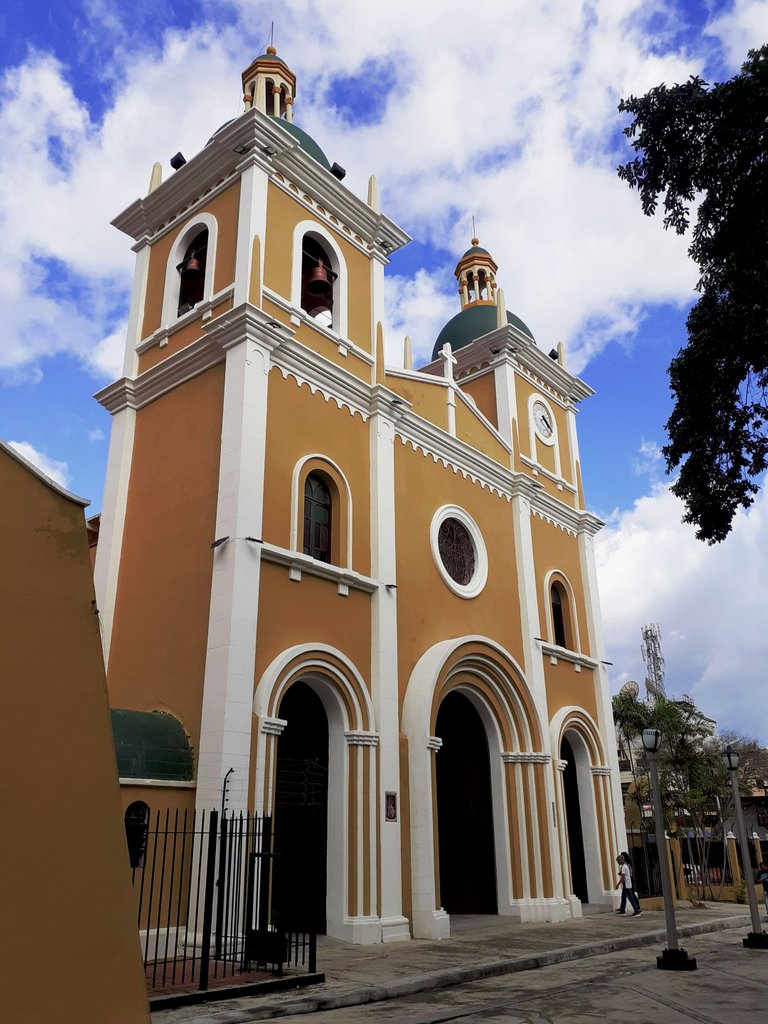
Without a doubt, it is a church with an interesting history. Personally, I was unaware of the details I am sharing with you, until I did some research for this publication.
Sin duda, es una iglesia con una historia interesante. En lo personal, desconocía los detalles que les comparto, hasta que investigué para hacer esta publicación.
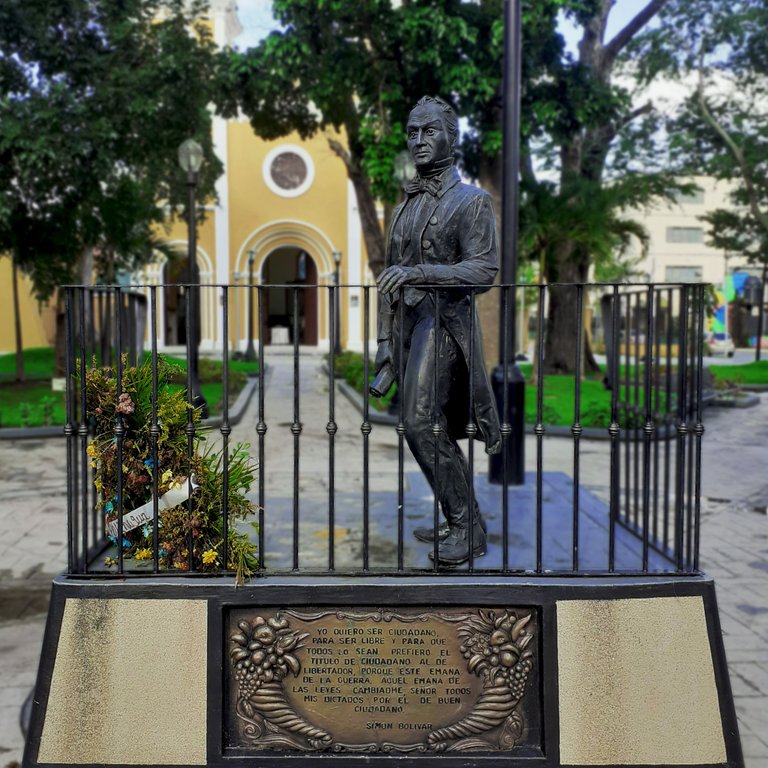
After taking several pictures of the church, I walked to the center of the square and photographed the Monument of the Liberator, which, curiously, occupies the place where there used to be a bust in honor of the Liberator. In 2007, this monument was inaugurated, replacing the previous one, and since then it is normal to see how some people leave flowers to pay homage to him or go up to take pictures.
Luego de sacar varias fotos a la iglesia, caminé hacia el centro de la plaza y fotografié el Monumento del Libertador, el cual, curiosamente, ocupa el lugar en el que antes había un busto en honor al mismo. En el año 2007, se inauguró este monumento, reemplazando de esta forma el anterior, y desde entonces es normal ver cómo algunas personas dejan flores para homenajearlo o suben para tomarse fotos.
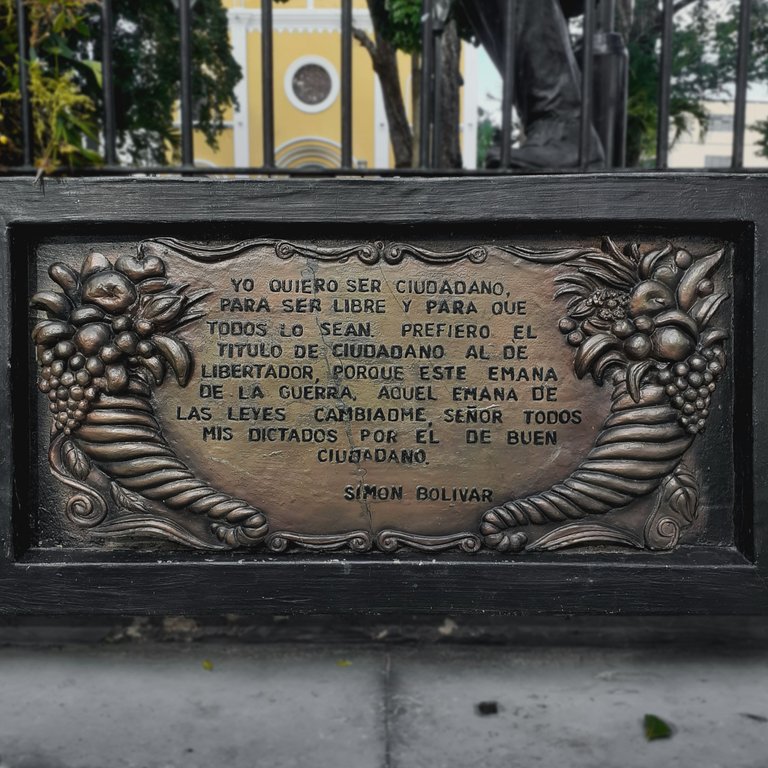
The inscription reads as follows:
"I want to be a citizen, to be free and for all to be free. I prefer the title of citizen to that of Liberator, because the latter emanates from war, the former emanates from laws. Change me, Lord, all my dictatorship for that of good citizen."
-Simon Bolivar.
En la inscripción, puede leerse lo siguiente:
"Yo quiero ser ciudadano, para ser libre y para que todos lo sean. Prefiero el título de ciudadano al de Libertador, porque este emana de la guerra, aquel emana de las leyes. Cambiadme, Señor, todos mis dictador por el de buen ciudadano."
—Simón Bolívar.

When editing, I blurred the background to give more prominence to the monument. The first photo was the most difficult and perhaps the one with the most imperfections, however, I hope to improve with time.
Finally, I want to show you some of these black and white photographs. Thank you for watching and reading.
Al momento de editar, desenfoqué el fondo para dar más protagonismo al monumento. La primera foto fue la más difícil y quizá la que más imperfecciones tiene, sin embargo, espero mejorar con el tiempo.
Por último, quiero mostrarles algunas de estas fotografías en blanco y negro. Gracias por ver y leer.
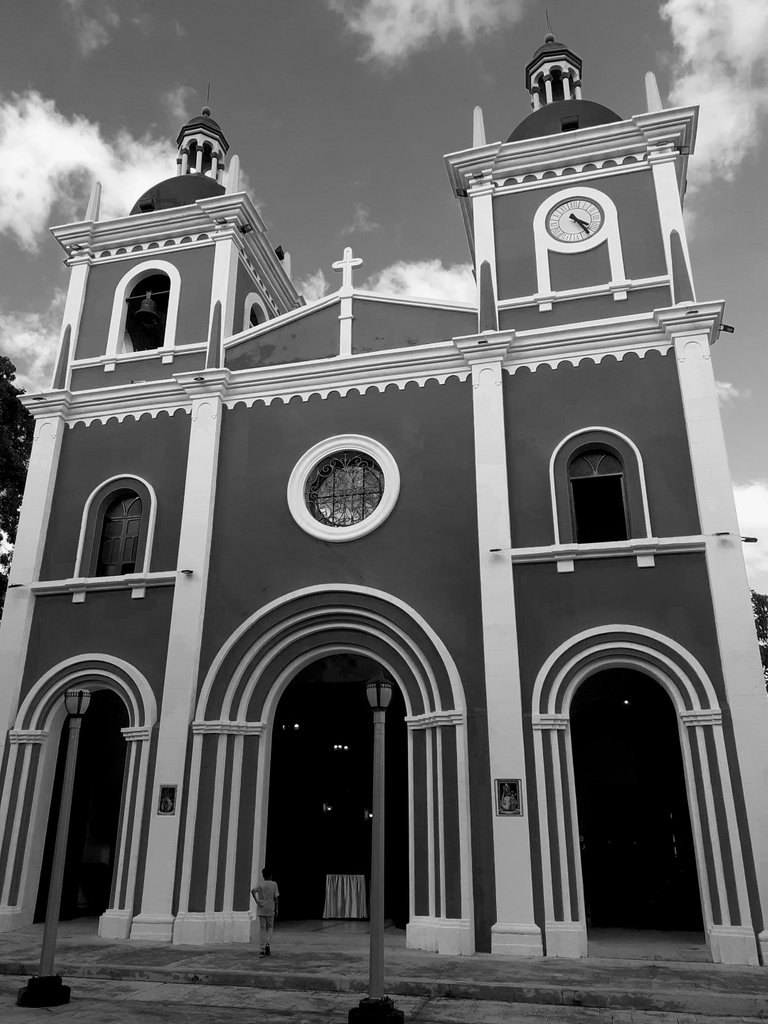
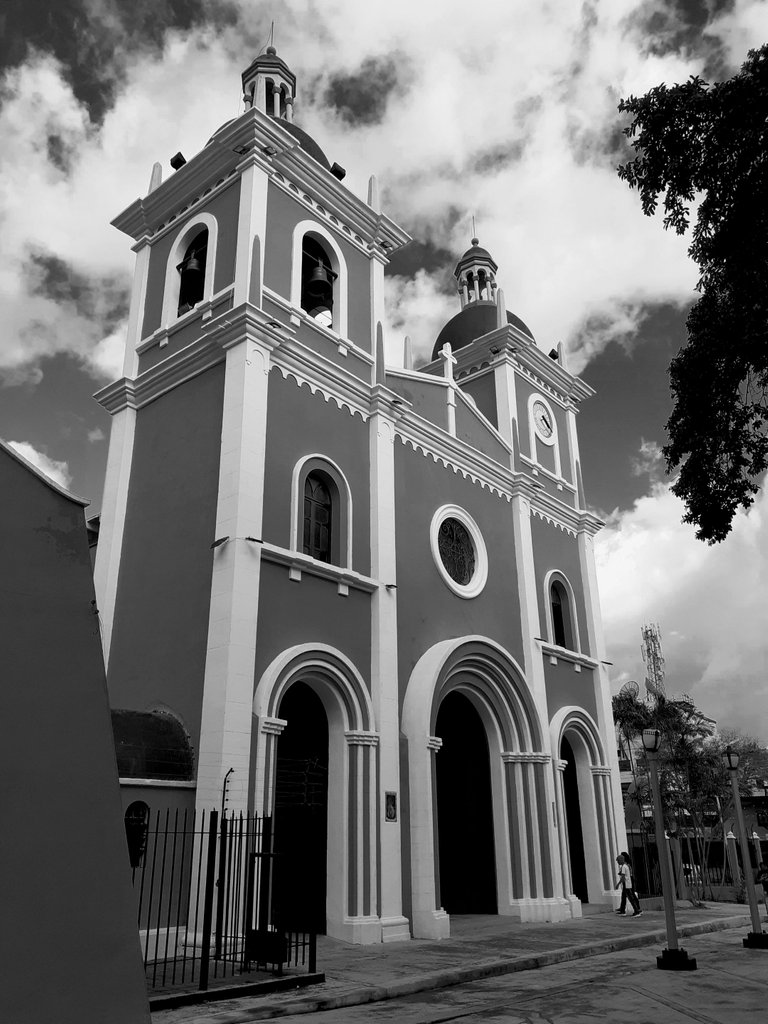
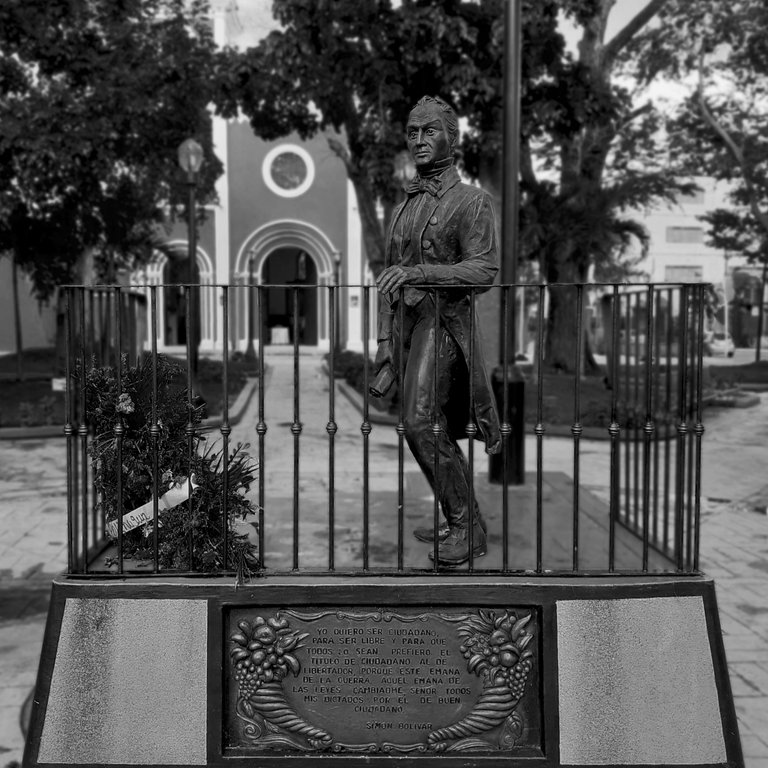
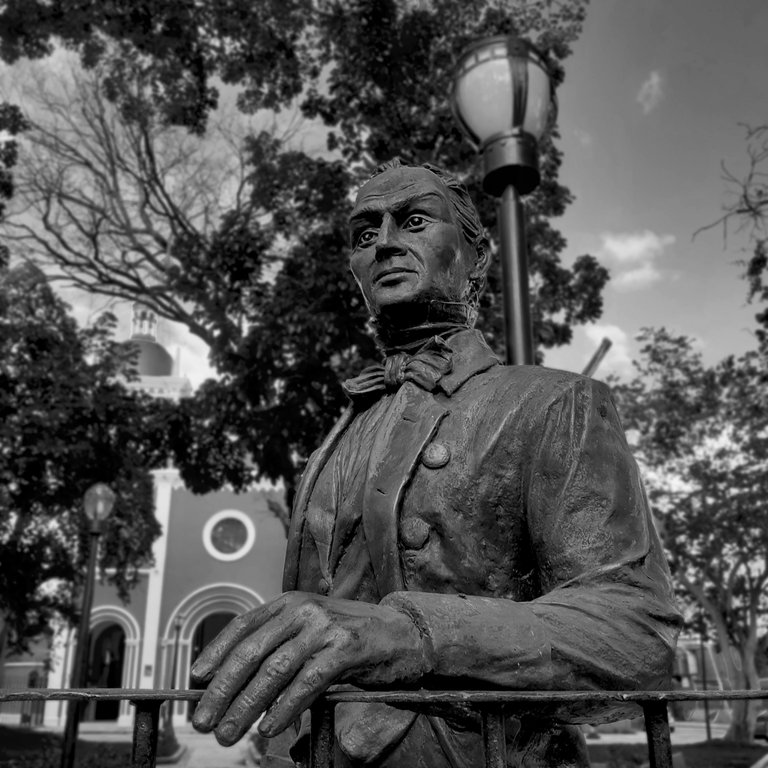

References / Referencias:
• Instituto del Patrimonio Cultural. (2006). Catálogo del Patrimonio Cultural Venezolano. Región Central. Estado Carabobo. Municipio Naguanagua. (1ra ed.).
• Alcántara Borges, A. (3da.). (2009). NAGUANAGUA (Bosquejo Geográfico, Demográfico, Histórico y Toponímico). Concejo Municipal Bolivariano de Naguanagua.
• Guinand Castellanos, R. (1ra.). (2010) . Naguanagua - La Begoña. Cosmográfica, C. A.

• Photographs of my authorship, taken with a Samsung Galaxy A10.
• Graphic resources: I.
• Design and edition: Photoshop CS6.
• Translation: Deepl (free version)
• Fotografías de mi autoría, tomadas con un Samsung Galaxy A10.
• Recursos gráficos: I.
• Diseño y edición: Photoshop CS6.
• Traductor: Deepl (versión gratuita)

!discovery 37
Muchas gracias por el apoyo.
This post was shared and voted inside the discord by the curators team of discovery-it
Join our Community and follow our Curation Trail
Discovery-it is also a Witness, vote for us here
Delegate to us for passive income. Check our 80% fee-back Program
Thanks for the support!
Las fotos de la iglesia son monumentales, qué imponente su fachada.
Y muy buenas capturas de ella.
Gracias por pasar y apreciar, querida amiga. Un abrazo.
Que linda iglesia y que bonita arquitectura. Tanto a color como en blanco y negro se ve bonita.
No soy de ir mucho a iglesias pero debo admitir que me llama mucho la atencion la edificacion, sobre todo de las mas antiguas, con esos detalles que te preguntas: ¿Cómo lo hicieron? jeje
Saludos amigo ❤️
Tampoco suelo frecuentar iglesias, pero no se puede negar el atractivo de la arquitectura de algunas; las de estilo gótico son mis preferidas. Gracias por la visita, Yami. Un abrazo ❤️
Has sido curado por @visualblock / You've been curated by @visualblock
Bienvenidas delegaciones / Delegations welcome
Trail de Curación / Curation Trail
Vota por nuestro Testigo aliado - @hispapro / Vote for our allied Witness - @hispapro
Más información sobre el testigo aquí / More information about the witness here
Agradecido por el apoyo. Saludos.
Tu publicación bien lo merece, magníficas fotografías. 🤗
Estas fotos están buenísimas, me encanta cómo se ve la fachada 🤗. Saludos, @juniorgomez.
Me contenta que te hayan gustado. Gracias por la visita, @vezo. ¡Saludos!